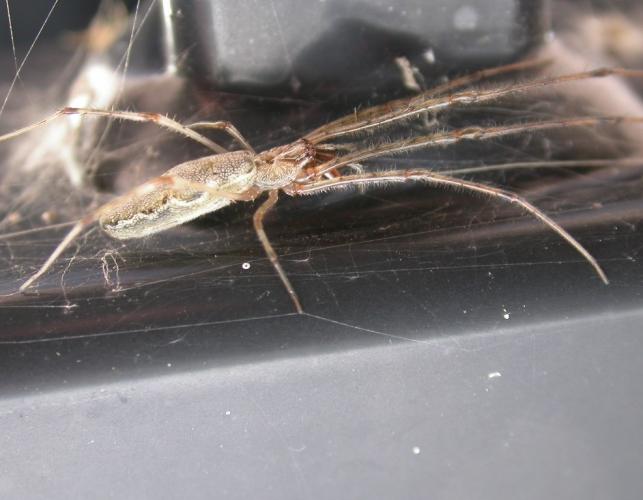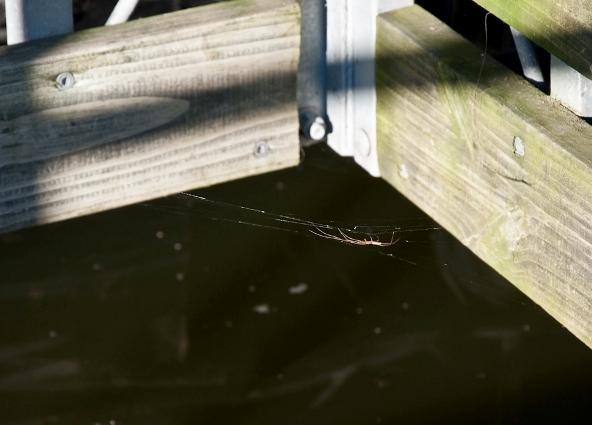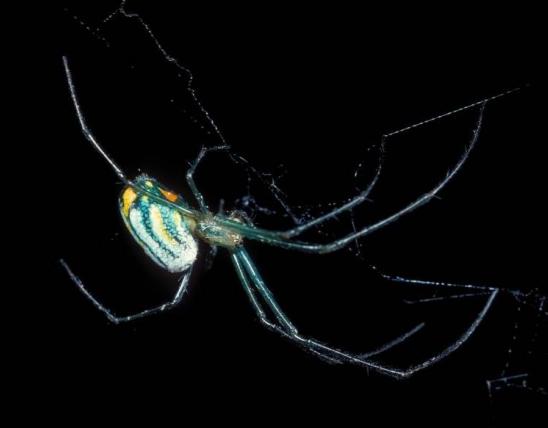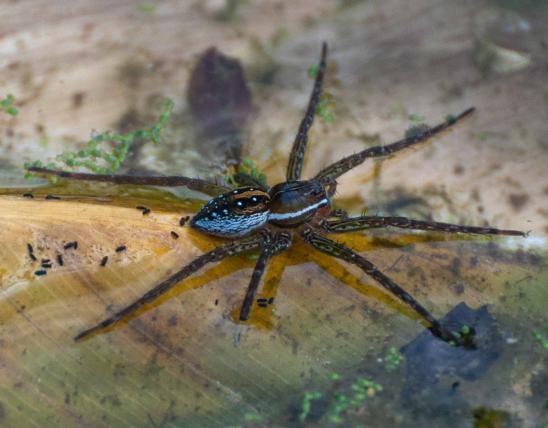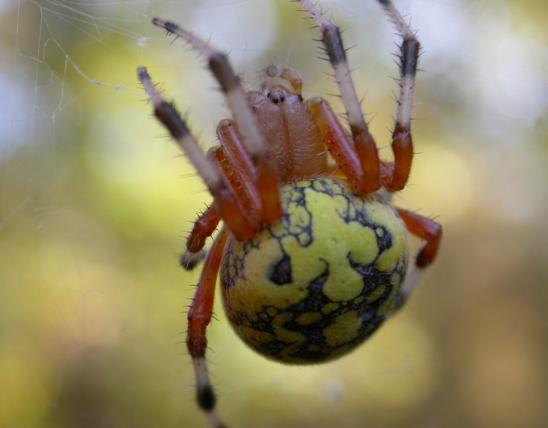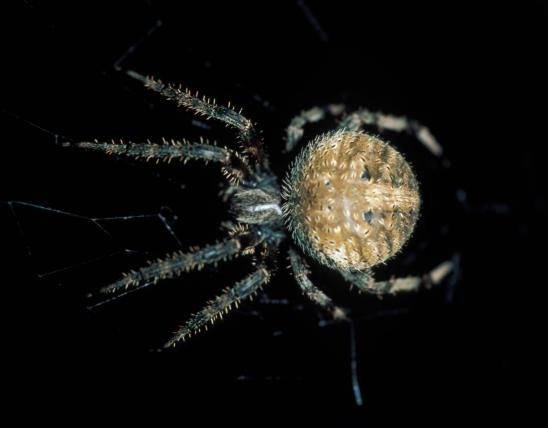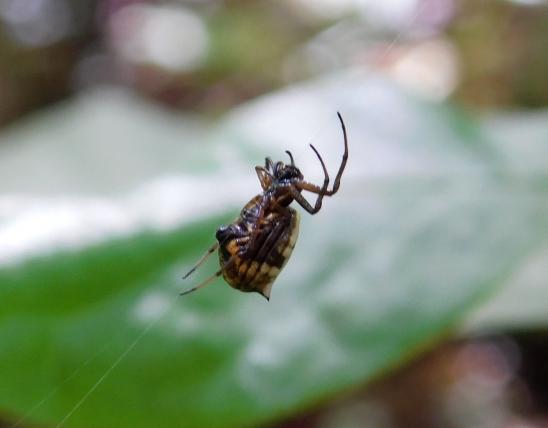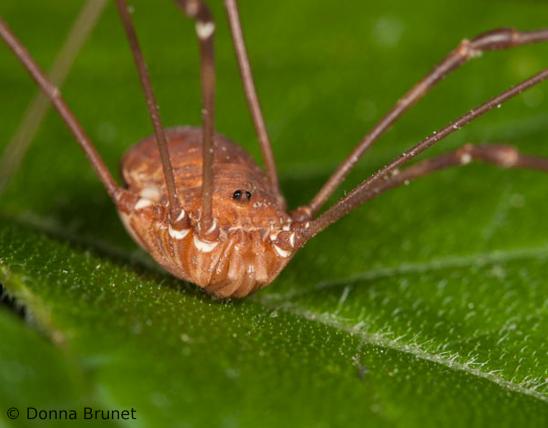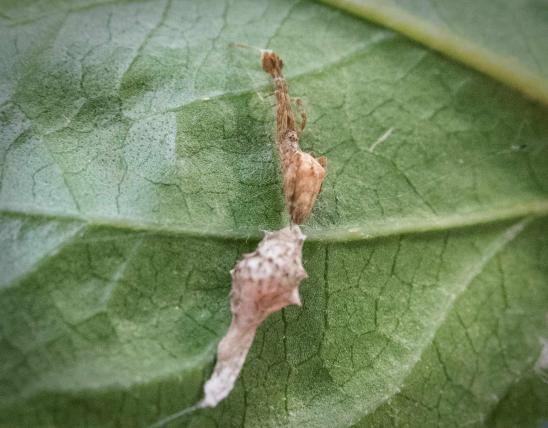
Longjawed orbweavers are often called “stretch spiders” because they often rest with their two front pairs of legs stretched straight out in front of them, and the last pair outstretched behind. Combined with their slender bodies and gray, tan, brownish, rusty, yellowish, or green, variably marked coloration, they can hide easily while clinging to a blade of grass or other plant with their rather short third pair of legs. Even when resting in their webs, they often look like an ordinary small twig. As the name implies, the chelicerae (“jaws” or “fangs”) of this group are extra long, compared to those of other orbweavers. The chelicerae of males are especially long — the male and female grip each other’s chelicerae during mating — and the enlarged tips of his palps (fingerlike structures near the mouth) look a little like tiny boxing gloves.
There are about 15 species in this family in North America. To separate the species, one must examine fine anatomical details, such as the “teeth” of the chelicerae, the form of the sexual organs, and the relative positioning of the eyes.
Similar species: The orchard orbweaver (Leucauge venusta) is a common Missouri spider that is in the same family. It is usually yellow-green with a red, orange, or yellow dot on its belly, which is usually facing upward as they rest in their webs. Several other spiders also stretch lengthwise, but they generally do not build horizontal orb webs over water or share other characteristics with this genus.
Length: usually to no more than about ½ inch (not including the legs).
Statewide.
Habitat and Conservation
Longjawed orbweavers spin circular (orb) webs that are usually positioned horizontally or slightly angled from the horizontal (not vertically as in most other orbweavers). Large species in this family typically live in vegetation along a water’s edge — in shoreline shrubs whose branches overhang ponds, lakes, rivers, and streams, usually in shady places. They often live along the sides of docks and piers, too. When not in their web, many longjawed orbweavers hide under branches, railings, or other sheltered locations nearby. If they are startled, they typically drop immediately down. If they fall into the water, they can run across the surface like fishing spiders and water striders do. Small species in this genus generally live in fields and grasslands.
Food
The horizontal webs are usually positioned within a few feet of the water’s surface, which makes them perfect nets for catching aquatic insects that have just emerged in their winged adult forms: mayflies, midges, stoneflies, and so on. Other prey includes lacewings, adult antlions, and many other small flying insects.
Status
The “longjawed” common name is quite apt: the chelicerae (“jaws”) of spiders in this genus are very long and almost armlike. The genus name, Tetragnatha, means four-jawed, apparently because the large chelicerae plus the two rather long palps makes it look like they have four “jaws.” Longjawed orbweavers and orchard orbweavers, in the family Tetragnathidae, are in a different family than “true” orb-weaving spiders, which are in the family Araneidae. Among their differences from true orbweavers, tetragnathids have longer jaws and have fewer “spokes” in their orb webs.
Life Cycle
Longjawed orbweavers use their long jaws in mating: the male and female lock chelicerae, which apparently functions to keep the larger female from eating the smaller male while he uses one of his notably long palps to transfer sperm into the female’s genital opening. Often several males will be attracted to the same female’s web and may tussle with each other for mating rights. Apparently a female may mate several times, with the last male being the successful inseminator. For this reason, males of some species remain with the female after mating, to guard against other males getting access to her. The fluffy-looking egg clusters are adhered to leaves or stems of nearby vegetation. As with most other spiders in our area, the adults usually all die when the temperatures dip below freezing. Young spiderlings hatch the next spring.
Human Connections
Some of the most “buggy” places in Missouri are in lowlands near water. This is where hosts of flying insects, many obnoxious to people, congregate. Longjawed orbweavers, building their webs right over the water, help to keep the numbers of these insects in check. Next time you see a tetragnathid on your boat dock, thank her for her free pest control services!
Ecosystem Connections
The cryptic coloration, body shape, and resting posture of these spiders reminds us that there are plenty of animals that would eat them if they could see them. It also reminds us that their prey would avoid them if they can.

